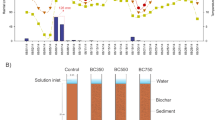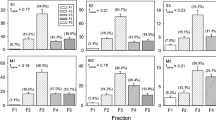Abstract
Struvite (MgNH4PO4·6H2O; MAP) can be recovered from animal and human wastes for use as fertilizer. This encourages the sustainable use of phosphorus (P), closing the human P cycle. The toxic metalloid chromium (Cr) is a common component of wastes, and can substitute for P in geochemical and biological systems. Thus, its sorption to, and effect on the stability and composition of recovered MAP requires assessment. MAP precipitated from solutions with 1–100 μM Cr(III) had higher Cr loadings compared to those reacted in the presence of Cr(VI), indicative of higher sorption affinity of the lower oxidation state. Simultaneous thermal analysis of unreacted MAP revealed an endothermic peak at 126 ± 0.5 °C by DSC with a mass loss of 52.9% by TG. Sorption of Cr produced minimal effects on the transition temperature and overall mass loss. The inflection in the TG curve indicated that Cr increased the temperature of maximum decomposition, but also the mass loss at this point. Combining TG results with FT-IR spectra revealed that for initial concentrations of 10–50 μM Cr(III) and 1–5 μM Cr(VI), NH4 + was added, and H2O(s) lost from the MAP structure. The change in composition was consistent with substitution of Cr(III) or Cr(VI) into the MAP structure. The TG/DSC–FT-IR technique confirmed that Cr contamination affects the MAP composition and may accelerate the release of nutrients upon mineral decomposition. This has implications for the use of MAP fertilizers and subsequent cycling of P and contaminants in agricultural systems.




Similar content being viewed by others
References
Elser J, Bennet E. A broken biogeochemical cycle. Nature. 2011;478:29–31.
de-Bashan LE, Bashan Y. Recent advances in removing phosphorus from wastewater and its future use as fertilizer (1997–2003). Water Res. 2004;38:4222–46.
Arakane M, Imai T, Murakami S, Takeuchi M, Ukita M, Sekine M, Higuchi T. Resource recovery from excess sludge by subcritical water combined with magnesium ammonium phosphate process. Water Sci Technol. 2006;54:81–6.
Ro KS, Cantrell K, Elliott D, Hunt PG. Catalytic wet gasification of municipal and animal wastes. Ind Eng Chem Res. 2007;46:8839–45.
Borgerding J. Phosphate deposits in digestion systems. J Water Pollut Control Fed. 1972;44:813–9.
Suzuki K, Tanaka Y, Osada T, Waki M. Removal of phosphate, magnesium and calcium from swine wastewater through crystallization enhanced by aeration. Water Res. 2002;36:2991–8.
Yi W, Lo KV, Mavinic DS, Liao PH, Koch F. The effects of magnesium and ammonium additions on phosphate recovery from greenhouse wastewater. J Environ Sci Health. 2005;40:363–74.
Escher BI, Wouter P, Suter MJF, Maurer M. Monitoring the removal efficiency of pharmaceuticals and hormones in different treatment processes of source-separated urine with bioassays. Environ Sci Technol. 2006;40:5095–101.
Ronteltap M, Maurer M, Hausherr R, Gujer W. Struvite precipitation from urine—influencing factors on particle size. Water Res. 2010;44:2038–46.
Peterson AA, Vogel F, Lachance RP, Fröling M, Antal MJ, Tester JW. Thermochemical biofuel production in hydrothermal media: a review of sub-and supercritical water technologies. Energy Environ Sci. 2008;1:32–65.
Childers DL, Corman J, Edwards M, Elser JJ. Sustainability challenges of phosphorus and food: solutions from closing the human phosphorus cycle. Bioscience. 2011;61:117–24.
Ronteltap M, Maurer M, Gujer W. The behaviour of pharmaceuticals and heavy metals during struvite precipitation in urine. Water Res. 2007;41:1859–68.
Uysal A, Yilmazel YD, Demirer GN. The determination of fertilizer quality of the formed struvite from effluent of a sewage sludge anaerobic digester. J Hazard Mater. 2010;181:248–54.
Fendorf SE. Surface reactions of chromium in soils and waters. Geoderma. 1995;67:55–71.
Abdelrazig BEI, Sharp JH. Phase changes on heating ammonium magnesium phosphate hydrates. Thermochim Acta. 1988;129:197–215.
Sarkar AK. Hydration/dehydration characteristics of struvite and dittmarite pertaining to magnesium ammonium phosphate cement systems. J Mater Sci. 1991;26:2514–8.
Afzal M, Iqbal M, Ahmad H. Thermal analysis of renal stones. J Therm Anal. 1992;38:1671–82.
Frost RL, Weier ML, Erickson KL. Thermal decomposition of struvite implications for the decomposition of kidney stones. J Therm Anal Calorim. 2004;76:1025–33.
Wakamura M, Kandori K, Ishikawa T. Influence of chromium(III) on the formation of calcium hydroxyapatite. Polyhedron. 1997;16:2047–53.
Zapata B, Balmaseda J, Fregoso-Israel E, Torres-García E. Thermo-kinetics study of orange peel in air. J Therm Anal Calorim. 2009;98:309–15.
Miller TW. Use of TG/FT-IR in material characterization. J Therm Anal Calorim. 2011;106:249–54.
Hu Q, Jin HL, Chen XA, Wang S. Thermal and FT-IR spectral studies of N,N′-diphenylguanidine. J Therm Anal Calorim. 2011. doi:10.1007/s10973-011-1948-0.
Jingyan S, Zhiyong W, Yuwen L, Cunxin W. Investigation of thermal behavior of enoxacin and its hydrochloride. J Therm Anal Calorim. 2011. doi:10.1007/s10973-011-1817-x.
Parkhurst DL, Appelo CAJ. User’s guide to PHREEQC (version 2)—a computer program for speciation, batch-reaction, one-dimensional transport, and inverse geochemical calculations. U.S. Geological Survey Water-Resources Investigations Report 99-4259; 1999.
Ohlinger KN, Young TM, Schroeder ED. Predicting struvite formation in digestion. Water Res. 1998;32:3607–14.
Bouropoulos NC. Koutsoukos PG spontaneous precipitation of struvite from aqueous solutions. J Cryst Growth. 2000;213:381–8.
Ferraris G, Fuess H, Joswig W. Neutron diffraction study of MgNH4PO4.6H2O (struvite) and survey of water molecules donating short hydrogen bonds. Acta Crystallogr. 1986;B42:253–8.
Shashkova IL, Rat’ko AI, Kitikova NV. Removal of heavy metal ions from aqueous solutions by alkaline-earth metal phosphates. Colloids Surf A. 1999;160:207–15.
Le Corre KS, Valsami-Jones E, Hobbs P, Jefferson B, Parsons SA. Agglomeration of struvite crystals. Water Res. 2007;41:419–25.
González-Ponce R, García-López-de-Sá ME. Evaluation of struvite as a fertilizer: a comparison with traditional P sources. Agrochimica. 2007;51:301–8.
González-Ponce R, López-de-Sá EG, Plaza C. Lettuce response to phosphorus fertilization with struvite recovered from municipal wastewater. HortScience. 2009;44:426–30.
Rahman Md M, Liu YH, Kwag J-H, Ra CS. Recovery of struvite from animal wastewater and its nutrient leaching loss in soil. J Hazard Mater. 2011;186:2026–30.
Acknowledgements
Support for this project was jointly funded by The Professional Staff Congress and The City University of New York, PSC-CUNY Award No. 63304. Thanks to Evert Elzinga, Jeffrey Fitts, and Alain Plante whose comments improved this manuscript.
Author information
Authors and Affiliations
Corresponding author
Rights and permissions
About this article
Cite this article
Rouff, A.A. The use of TG/DSC–FT-IR to assess the effect of Cr sorption on struvite stability and composition. J Therm Anal Calorim 110, 1217–1223 (2012). https://doi.org/10.1007/s10973-011-2101-9
Received:
Accepted:
Published:
Issue Date:
DOI: https://doi.org/10.1007/s10973-011-2101-9




